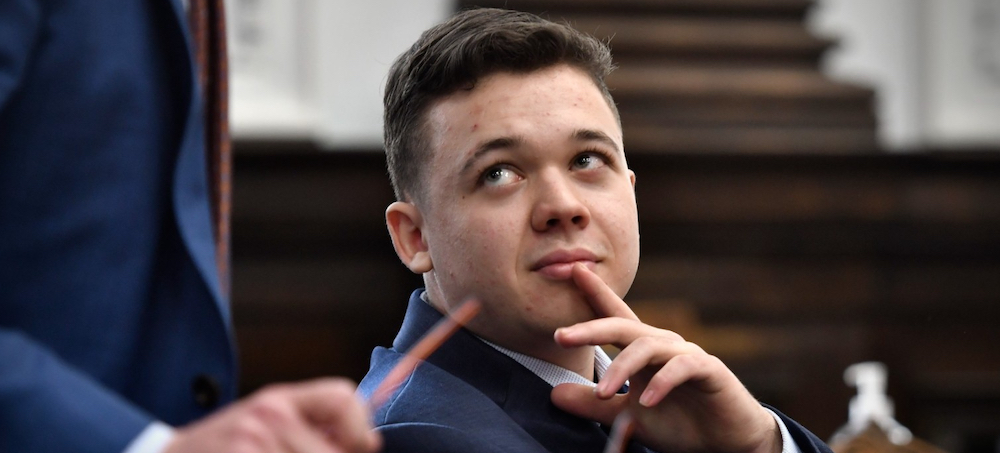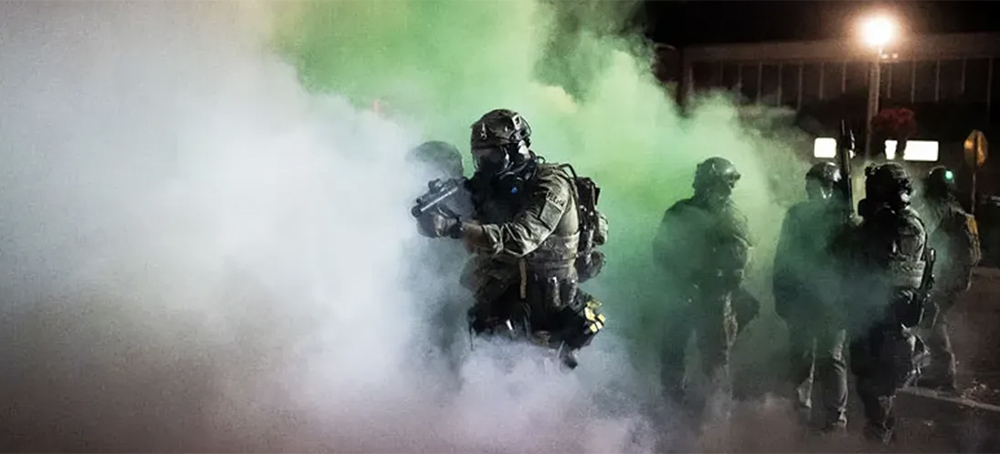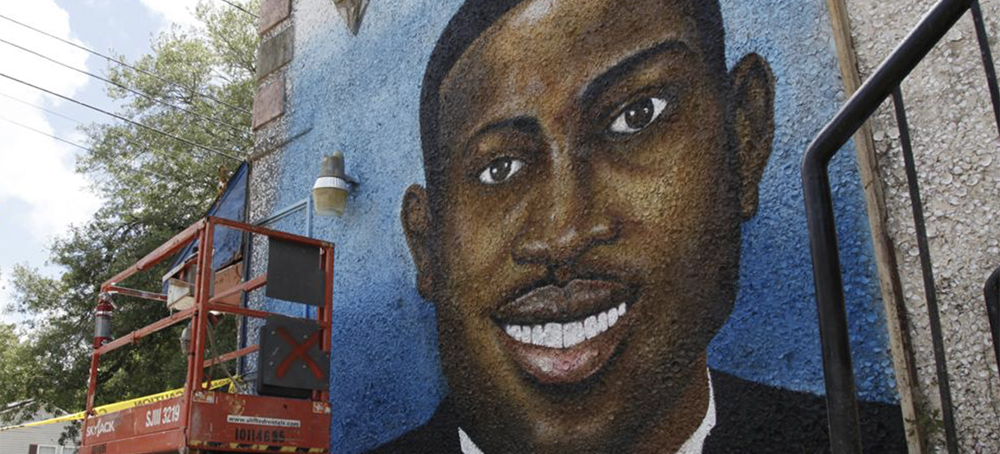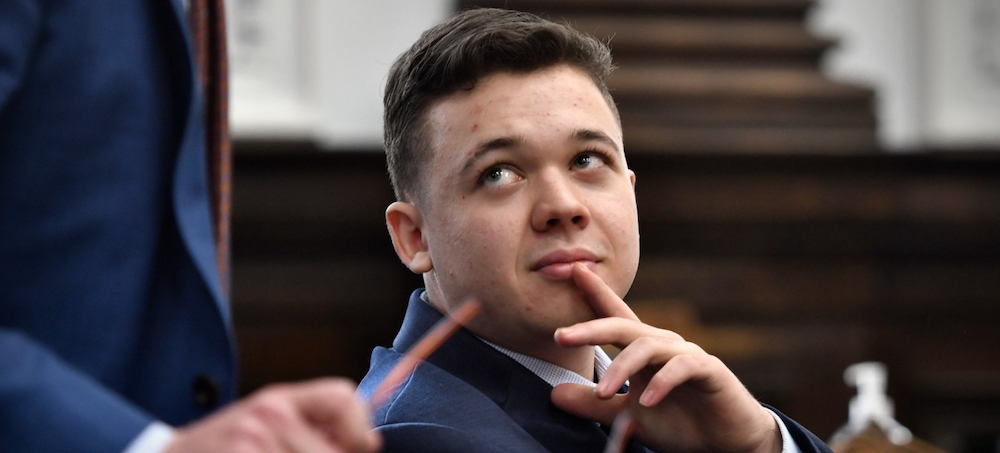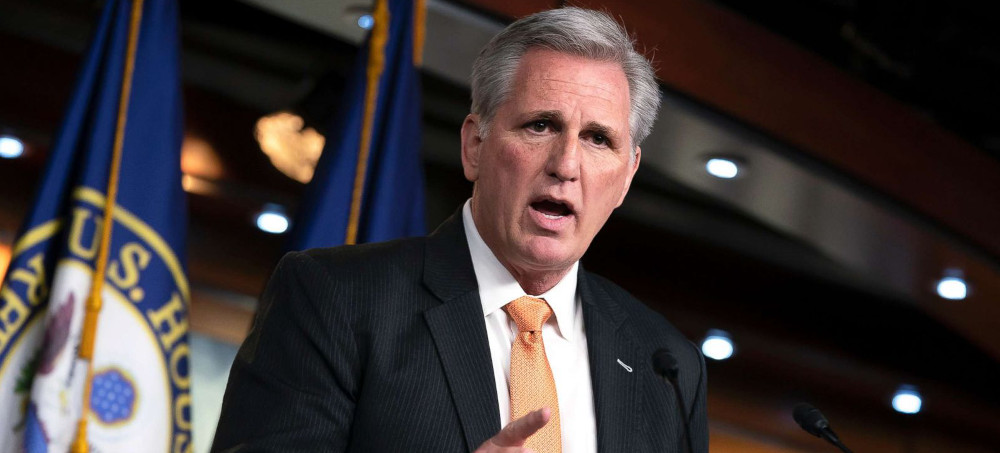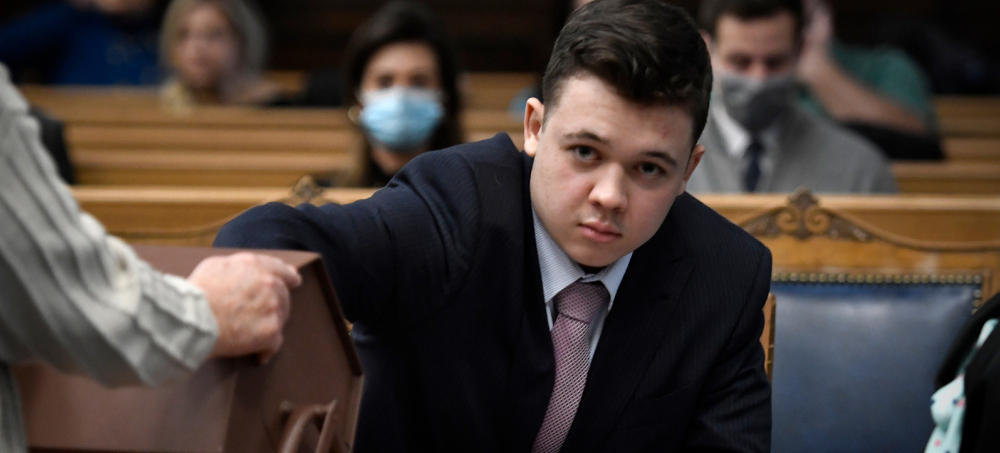Live on the homepage now!
Reader Supported News
A Wisconsin self-defense law made it difficult for the jury to convict—an outcome that was celebrated by the Republican Party’s violent fringe.
The jurors were debating whether Rittenhouse committed felonies or acted in self-defense when, just before midnight on August 25, 2020, he fired an AR-15-style semi-automatic rifle eight times. Rittenhouse, who was then seventeen, lived just across the Illinois border. After watching live streams of the violent protests that erupted in Kenosha following the police shooting of a Black man, Jacob Blake, he joined his best friend, Dominick Black, in guarding Car Source, a downtown business whose main sales lot had been torched. Both were armed with rifles that they had been keeping at Black’s stepfather’s home in Kenosha.
At trial, Rittenhouse faced a charge of first-degree reckless homicide for killing Joseph Rosenbaum, an enraged but unarmed man who had chased him; first-degree intentional homicide for killing Anthony Huber, a demonstrator who had struck him with a skateboard and then lunged for his rifle; two felony counts of recklessly endangering the safety of the Daily Caller’s video chief, Richie McGinniss, and a demonstrator who had kicked him in the head; and first-degree attempted intentional homicide for shooting Gaige Grosskreutz, a demonstrator and paramedic who was armed with a Glock pistol.
Initially, Rittenhouse also faced a misdemeanor count of unlawfully possessing a dangerous weapon. He was too young to have bought the rifle—Black bought it for him and now faces his own felony trial—but, to the surprise of many, the judge, Bruce Schroeder, dismissed it.
Two portraits of Rittenhouse emerged during the two-week trial. The defense portrayed him as a selfless teen-ager and aspiring law-enforcement officer or paramedic who wanted to help defend Kenosha and provide first aid. Prosecutors argued that Rittenhouse courted trouble by hubristically inserting himself into a volatile situation—he volunteered to help guard property that he did not own, in a city where he did not live, while flaunting, confusingly, both a first-aid kit and a semi-automatic rifle.
The Rittenhouse trial will be remembered for its voluminous video evidence and for live streamers’ role in either documenting, or negatively influencing, historic events. The footage—captured also by demonstrators, a civilian-operated drone, and an F.B.I. surveillance plane—showed every shooting from various angles. The jurors watched numerous clips of Rittenhouse in the moments before and after the shootings. He was interviewed by live streamers and shown yelling, “Anybody need medical?” Not long before the gunfire started, he lied about being an E.M.T. and bragged that, if there was trouble, “I’m running into harm’s way.”
There were also notable, and loud, rebukes. After Rittenhouse’s attorneys moved for a mistrial, accusing the state of overreaching, the lead prosecutor, Thomas Binger, tried to explain himself, but Schroeder boomed, “Don’t get brazen with me!” In one motion, Rittenhouse questioned the integrity of footage that prosecutors alleged showed him provocatively pointing his gun at people first. (One of the prosecutors wearily remarked, “We did not alter the file,” adding, “None of us know how to alter the file.”) The judge acknowledged that the footage made him “very queasy,” but he allowed it.
Putting a criminal defendant on the witness stand is always risky, but Rittenhouse, who had wanted to tell his side of the story since police detectives first questioned him, took the stand for nearly an entire day, last week. When he appeared to break down, his supporters credited his courage; his detractors compared him to Brett Kavanaugh, ridiculing “white male tears.”
The public’s assessments of Rittenhouse’s performance coalesced, predictably, around the hyper-partisanship that distinguished the reactions to the Kenosha shootings from the start. As I reported, in detail, over the summer, opportunists seized on the case—often inaccurately—as a referendum on constitutional freedoms and American racial progress. Schroeder instructed the jurors to treat the defendant like any other witness, assessing him on such factors as credibility, conduct, appearance, demeanor, and apparent intelligence. He told them, “In everyday life, you determine for yourselves the reliability of things people say to you. You should do the same thing here.”
The jurors could be forgiven if they were confused about how to go about their deliberations—the judge sure was. On Monday morning, Schroeder was in the middle of reading thirty-six pages of instructions aloud when he said, “If you decide unanimously that the defendant did not commit the greater crime and was acting lawfully in self-defense”—then stopped. He paused for nineteen seconds, staring off into space and rubbing his fingers together, as he pondered how to explain a pathway to convicting Rittenhouse on lesser counts. Then he said, “I’ve got myself into a midsentence, and I don’t like it.” They worked it out, not to everyone’s satisfaction. At one point, Schroeder declared, “This is a more complicated case than most—than any, frankly, that I can remember.”
Americans had spent the past fifteen months debating Rittenhouse’s culpability, character, proclivities, motivations, and intelligence, and the extent to which he symbolized the country’s shifting relationship with guns—and with one another. The judgment that mattered was that of the seven women and five men of the jury, who were responsible for working through the complexities and nuances of each felony count, one by one.
Around lunchtime on Friday, after four days of deliberation, the jury reached a verdict. The parties were summoned to the courtroom. Rittenhouse took his place at the defense table. His mother, Wendy, and his two sisters, Faith and McKenzie, sat together, in a rear pew, alongside Dave Hancock, a security specialist and military veteran who has become the family’s most visible advocate. Across the aisle, loved ones of the dead clutched one another’s arms. The judge warned the audience to remain unemotional: “Many people do have strong feelings, but we can’t permit any kind of a reaction to the verdict.”
The mood was more tense than at any point during the trial. Rittenhouse, wearing the attentive expression that he had displayed all along, watched the jurors come to their chairs. The forewoman handed a bailiff a set of papers containing each charge—collectively known as “the information”—and each corresponding verdict. Schroeder leafed through the pages, then aligned them with one sharp crack. He said, “The defendant will rise and face the jury and hearken to its verdicts.”
Rittenhouse stood. The court clerk said, “As to the first count of the information—Joseph Rosenbaum—we, the jury, find the defendant, Kyle H. Rittenhouse, not guilty.” Wendy Rittenhouse jolted backward in her seat. By the third “not guilty,” Rittenhouse was losing his composure. On the fifth and final “not guilty,” his knees appeared to buckle.
The jurors were—and are—not required to reveal their calculus. By tradition, even their identities may not be made public. The Rittenhouse jury was known, by sight, only to those who physically attended the trial at the Kenosha County Courthouse. They were not sequestered. They were driven to and from the courthouse in what the judge called a “sealed” vehicle—a bus with blacked-out windows.
It was ultimately impossible to deduce meaning from their demographics or their behavior during the trial—juries are notoriously unpredictable. Was it better or worse—for the prosecution or the defense—that women outnumbered men? What did it mean that the jurors wanted to rewatch certain footage? And that, less than twenty-four hours before issuing the verdict, some of them were smiling? As he dismissed them, the judge told the jurors that they could talk to the media, if they wanted, about their deliberations. But they did not have to. He said, “Your job is done.”
The courtroom was half filled when the trial began, on November 2nd. By the end, the room was crowded, and a “zoo” had appeared outside. The Racine Journal Times clocked the presence of a man in a “pro-Second Amendment hoodie” and an enthusiastic trial watcher in a red fedora and matching boa. Mark McCloskey, the lawyer who pleaded guilty to pointing an “AR” at Black Lives Matter demonstrators, last year, outside his home in St. Louis, materialized in Kenosha, though he is running for a U.S. Senate seat in Missouri.
The public discourse that surrounded the trial bore little resemblance to the matter of law. A “Free Kyle” contingent saw no reason to hold Rittenhouse accountable for any of his actions in Kenosha. The true villains, in their eyes, were Antifa, the Black Lives Matter movement, and Democrats—whose actions, or lack thereof, forced civilians to defend communities against destruction and violence. Rittenhouse rejected the term “vigilante,” but some of his supporters baldly embraced it. On Wednesday night, the right-wing commentator Dinesh D’Souza told Laura Ingraham on Fox News, “When you don’t have rule of law, when the cops are nowhere to be found, vigilante justice is the only kind of justice you have.” The chyron read “Rittenhouse Trial Reveals a Culture in Decline.”
If the right saw the verdict as an affirmation of vigilantism, so, too, did their opponents. Moments after the verdict, the political consultant David Axelrod tweeted, “A dangerous, dangerous precedent.” Jake Spence, the state director of Wisconsin Working Families Party, called the outcome “an abject failure” of the criminal-justice system, whose presumed goal is “to promote well-being, public safety and justice for all.” The Atlantic contributor David French, a conservative and an Iraq War veteran who has written about his decision to carry a concealed weapon, recently observed that “one of the symbols of the American hard right is the ‘patriot’ openly carrying an AR-15 or similar weapon.” He described Rittenhouse as “the next step in that progression. He’s the ‘patriot’ who didn’t just carry his rifle; he used it.”
President Joe Biden, whose 2020 campaign used an image of Rittenhouse to disavow Donald Trump’s support of “white supremacists,” commented only that he stood by the verdict. His press secretary, Jen Psaki, told reporters that the President believes “we shouldn’t have, broadly speaking, vigilantes patrolling our communities with assault weapons. We shouldn’t have opportunists corrupting peaceful protest by rioting and burning down the communities they claim to represent, anywhere in the country.”
Rittenhouse did not have formal firearms training, yet Wisconsin’s law allowed him to openly carry a semi-automatic rifle, the type of weapon that is colloquially known as an AR-15. The “AR” stands not for “assault rifle,” as some believe, but rather for ArmaLite Rifle; ArmaLite was the company that manufactured the weapon in the nineteen-fifties, as the Pentagon sought a lightweight alternative to the M14 infantry rifle. As C. J. Chivers explains in “The Gun,” Colt’s firearms division bought the rights to the AR-15 in 1959 and field-tested it in the Vietnam War, promoting its “devastating” ability to penetrate almost anything. Chivers writes that “five to seven soldiers armed with AR-15s produced more firepower and were more dangerous than eleven soldiers provided with M-14s.”
When the patent expired, gun manufacturers mass-produced derivatives. Once the federal assault-weapons ban expired, in 2004, they became the most popular rifles in America. Rittenhouse was armed with Smith & Wesson’s version of the AR-15, which Chivers describes as “small, dark, lean, and synthetically futuristic.” Rittenhouse testified that he wanted an “AR” because he thought it “looked cool.”
In his reflections on the trial, French worried that “a political movement that turns a deadly and ineffective vigilante into a role model is a movement that is courting more violence.” And, in fact, it was far-right figures like the Proud Boys and Marjorie Taylor Greene who appeared most ardent in their support of Rittenhouse. After the verdict was announced, Madison Cawthorn, the North Carolina congressman who has advocated “bloodshed” and “storing up some ammunition” in defense of combatting “tyranny,” released a seven-second selfie-video celebrating Rittenhouse’s acquittal. On January 6th, Cawthorn spoke at Trump’s Stop the Steal rally, moments before insurrectionists stormed the U.S. Capitol. In his Rittenhouse video, he told followers, “You have a right to defend yourself! Be armed, be dangerous, and be moral.” Cawthorn, as well as his colleagues Matt Gaetz and Paul Gosar, expressed interest in offering Rittenhouse an “internship.”
Follow us on facebook and twitter!
PO Box 2043 / Citrus Heights, CA 95611

